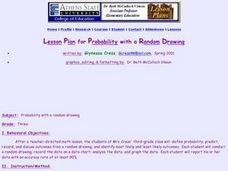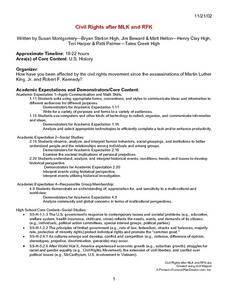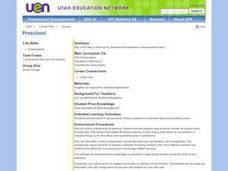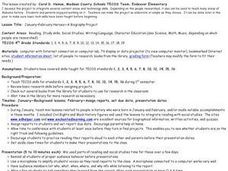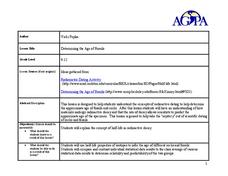Curated OER
The Spider Beside Her
Second graders expand their knowledge of spiders. By creating a model of a spider, 2nd graders recognize differences between spiders and insects and determine that a spider is not an insect.
Curated OER
TE Activity: A Roundabout Way to Mars
Young scholars investigate Hohmann orbit transfers using cardboard and string while focusing on the orbits of Earth and Mars. They look at the planets orbits around the sun and transfer orbit form one planet to another to determine what...
Curated OER
Is Organic Food Worth the Extra Cost?
Learners calculate the amount of pesticide residue in selected foods for two
pesticides and determine if these levels are safe. They read an article about a
research study looking for metabolites of these pesticides in children. Finally,...
Curated OER
Marshland Wonders
Students review the characteristics of wetlands and list their benefits. After viewing short videos, they identify the organims that make their home in wetlands and how they have adapted. They compare and contrast the characteristics...
Curated OER
Ecology
Learners gain an understanding of necessary components required within a healthy, sustainable environment and ways human actions can impact that balance while discovering how to recognize and analyze explanations and models used in...
Curated OER
Probability With a Random Drawing
Young scholars define probability, and predict, record, and discuss outcomes from a random drawing, then identify most likely and least likely outcomes. They conduct a random drawing, record the data on a data chart, analyze the data,...
Curated OER
Historic Cemeteries: "History Written in Stone"
Students examine grave markers in their local community. They identify how past generations contributed to life in their town. They discuss their feelings about death and how one is to act at a cemetary.
Curated OER
Do Different Colors Absorb Heat Better?
Students work together to test how the color of a material affects how much heat it absorbs. They make predictions and take notes on their observations. They discover how engineers use this type of information.
Curated OER
Smoke and Mirrors
Students develop a persuasive peer-to-peer case against smoking. They read two scenarios, perform a skit, and prepare a factual presentation.
Curated OER
What Color is Your Air Today?
Students investigate air quality. They analyze Air Quality Index data tables, interpret the graphs, complete a worksheet, and discuss trends in air quality.
Curated OER
Changes in Pulse Rate
Eighth graders practice making observations and collecting data after determining a baseline pulse rate then collect data on the changes in that rate with exercise. Students must organize their data and analyze their observations.
Curated OER
What Are the Literary, Artistic, Scientific, and Technological Contributions of Immigrants to the United States?
Young scholars evaluate impact of immigration on America's economy and culture, research information about people of various countries of origin, and share findings with classmates through collages, posters, handouts, or skits.
Curated OER
GET'N JIGGY WITH THE JITTERBUG
Twelfth graders research the history of the jitterbug dance through an interactive group project. The goal of the lesson plan is to get them to execute the dance steps independently with little outside help from the teacher. The steps...
Curated OER
Predator-Prey Relationships
Students explore the interrelatedness of predators and prey in four different activities. They simulate an aquatic insect, fish, and osprey food chain during a poker chip game, play an M&M game to simulate the relationship between...
Curated OER
Observing Mealworms and Earthworms
Fifth graders examine the lifecycles of earthworms and mealworms. In groups, they make sketches, measure, and read about mealworms and earthworms. They travel between stations to examine a different part of their lives. To end the lesson...
Curated OER
Civil Rights after MLK and RFK
Learners are assigned to groups representing minority populations who produce a research project in a digital format from the list. A few of the choices are: speech, letter to the editor, editorial cartoon, etc.
Curated OER
Don't Just Stand By
Learners discuss what it means to be a bystander to bullying and why it is difficult to help and support friends who are being affected by bullying. They brainstorm ways to overcome these challenges and are provided with strategies for...
Curated OER
Preschool
Students experience various types of play. They determine play is the way a child learns and describe the value of play. They discover that play is a child's natural way of learning and that children test and practice new physical,...
Curated OER
A Hero Biography Project
Fourth graders study historical significant people born in January and February and note their accomplishments. Using given websites, 4th graders collect biographical information and participate in activities about a specified hero. ...
Curated OER
Determining the Age of Fossils
Students examine the concept of radioactive dating. In this radioactive dating lesson plan, students investigate how to determine the ages of fossils and rocks as they learn about half-life radioactive decay.
Curated OER
Everything's Connected
Students explore how trash decomposes. In this ecosystem lesson, students discuss new vocabulary words, such as producers and consumers, and think critically to answer how landfills work.
Alabama Learning Exchange
I Will Survive
Young scholars explore animal adaptations. In this animal science lesson, students watch the video "Kratt's Kreatures" and work in groups to complete a worksheet about animal adaptations.
Curated OER
Look At Those Leaves!
Young scholars sort tree leaves. In this plant biology lesson plan, students collect leaves and group them according to size, shape, and color. Young scholars discuss their observations.
Curated OER
Guess What I Came From
First graders examine items made from plants. In this plant lesson plan, 1st graders read Plants Feed on Sunlight and view a PowerPoint presentation regarding plant growth. Students examine products that are made from plants and draw...







